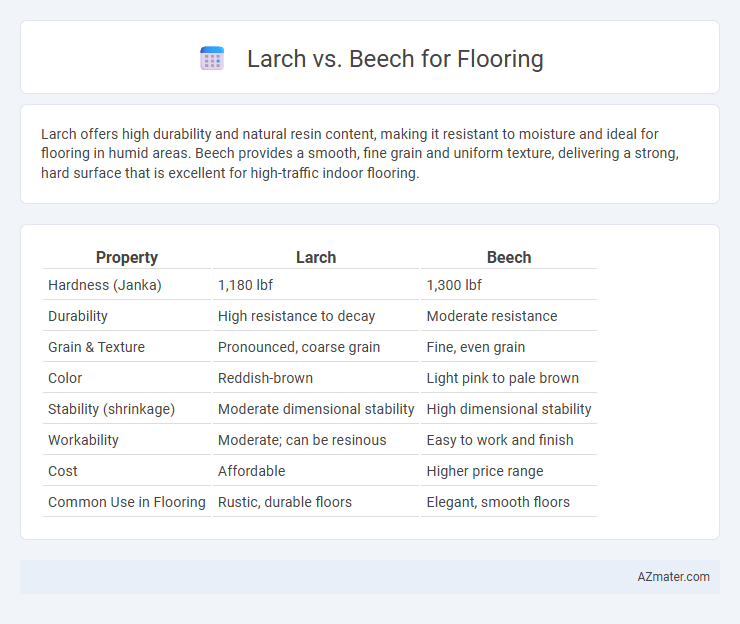Larch offers high durability and natural resin content, making it resistant to moisture and ideal for flooring in humid areas. Beech provides a smooth, fine grain and uniform texture, delivering a strong, hard surface that is excellent for high-traffic indoor flooring.
Table of Comparison
| Property | Larch | Beech |
|---|---|---|
| Hardness (Janka) | 1,180 lbf | 1,300 lbf |
| Durability | High resistance to decay | Moderate resistance |
| Grain & Texture | Pronounced, coarse grain | Fine, even grain |
| Color | Reddish-brown | Light pink to pale brown |
| Stability (shrinkage) | Moderate dimensional stability | High dimensional stability |
| Workability | Moderate; can be resinous | Easy to work and finish |
| Cost | Affordable | Higher price range |
| Common Use in Flooring | Rustic, durable floors | Elegant, smooth floors |
Introduction to Larch and Beech Flooring
Larch flooring, known for its exceptional durability and distinctive reddish hue, offers a rustic yet elegant aesthetic that enhances both traditional and modern interiors. Beech flooring features a fine, consistent grain pattern with a warm, creamy color, providing a smooth and uniform surface ideal for high-traffic areas. Both hardwood options deliver strong wear resistance and natural stability, making them popular choices for long-lasting and visually appealing flooring solutions.
Visual Appearance and Aesthetics
Larch flooring showcases a natural, rustic appearance with distinct, prominent grain patterns and warm reddish-brown hues that deepen over time, making it ideal for creating cozy, inviting spaces. Beech flooring offers a more uniform, fine grain and pale, creamy color that brightens interiors and suits modern, minimalist designs. The choice between larch and beech for flooring hinges on whether a bold, textured look or a smooth, subtle aesthetic is preferred.
Hardness and Durability Comparison
Larch wood ranks around 830 on the Janka hardness scale, making it moderately hard and resistant to dents and scratches, whereas Beech scores higher at approximately 1,300, offering superior hardness and wear resistance for flooring applications. Beech's dense grain structure contributes to exceptional durability and longevity, ideal for high-traffic areas, while Larch provides good dimensional stability and natural resistance to moisture, enhancing its suitability for varied indoor environments. Choosing between Larch and Beech flooring largely depends on the required hardness level and durability needs, with Beech favored for robustness and Larch for balanced performance and moisture resilience.
Resistance to Moisture and Decay
Larch wood exhibits exceptional resistance to moisture and decay due to its high resin content and dense grain structure, making it ideal for damp environments and areas prone to humidity. Beech, while hard and durable, is more susceptible to moisture damage and fungal decay if not properly treated or sealed, limiting its effectiveness in wet conditions. Choosing larch flooring enhances longevity and performance in moisture-prone spaces, whereas beech flooring requires careful maintenance to prevent deterioration.
Maintenance Requirements
Larch flooring demands moderate maintenance due to its natural resistance to moisture and decay, requiring regular cleaning and periodic resealing to preserve its durability and appearance. Beech flooring, known for its hardness, necessitates consistent care such as sweeping and occasional refinishing to prevent scratches and dents caused by high foot traffic. Both wood types benefit from controlled indoor humidity levels to avoid warping and ensure long-lasting flooring quality.
Environmental Sustainability
Larch flooring offers superior environmental sustainability due to its fast growth rate and natural durability, reducing the need for chemical treatments and frequent replacements compared to beech. Beech flooring, harvested from slower-growing hardwood forests, often involves greater ecological impact and longer regeneration periods, which can contribute to deforestation concerns. Sustainable certifications like FSC or PEFC ensure both larch and beech are sourced responsibly, but larch aligns better with eco-friendly building practices by balancing durability and rapid renewability.
Installation Considerations
Larch flooring offers greater dimensional stability and natural resistance to moisture, making it easier to install in humid or variable environments compared to beech. Beech requires acclimatization to indoor conditions to prevent warping and expansion after installation, necessitating precise moisture content control. Both woods benefit from professional subfloor preparation, but larch's durability allows for faster installation with fewer acclimation concerns.
Cost Analysis: Larch vs Beech
Larch flooring typically costs between $4 to $7 per square foot, offering a more budget-friendly option compared to Beech, which ranges from $6 to $10 per square foot. Larch's dense grain structure provides durability at a lower price point, making it ideal for high-traffic areas without compromising quality. Beech, while more expensive, boasts a fine, uniform texture that adds elegance and is preferred for premium flooring projects where aesthetic appeal justifies the cost.
Common Applications and Best Uses
Larch flooring is commonly used in rustic and outdoor settings due to its natural water resistance and durability, making it ideal for cabins, patios, and high-moisture areas. Beech flooring is best suited for indoor residential spaces like living rooms and kitchens, valued for its fine grain, smooth texture, and consistent hardness that provides a uniform finish. Both woods are favored in commercial settings, with larch preferred for high-traffic, moisture-prone environments and beech chosen for aesthetic appeal and ease of maintenance.
Final Verdict: Which Wood Suits Your Floor?
Larch flooring offers superior durability and resistance to moisture, making it ideal for high-traffic or humid areas, while beech flooring provides a smoother, more uniform grain ideal for elegant, warm interiors. The final choice depends on usage patterns and aesthetic preferences: larch excels in robust performance and rustic appeal, whereas beech suits spaces prioritizing refined looks and moderate wear. Selecting between larch and beech flooring hinges on balancing hardness ratings, moisture tolerance, and desired visual texture to ensure long-lasting satisfaction.

Infographic: Larch vs Beech for Flooring
 azmater.com
azmater.com